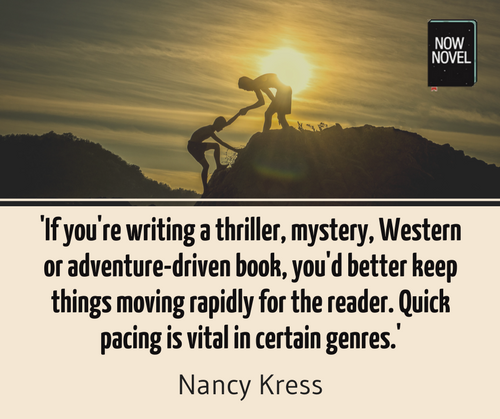There are multiple factors that determine narrative pace, the rate at which your story's narrated action unfolds. Tone and word choice are two factors. Yet having a good command of grammar helps too. Try these tips to build better pacing:
1. Master the participial phrase
A participle is a verb used as an adjective. Present participles ending in '-ing' (e.g. 'running', 'falling' or 'dancing') are useful for building pace because:
- You can use these words to show simultaneous actions, creating an action-oriented 'eventfulness' that builds pace
- They create a sense of events 'in motion'
For example, consider this example using a 'participial phrase' (a phrase containing a participle that functions as an adjective):
'Taking off his jacket at the front desk, Jack flinched when a familiar, unexpected voice spoke close to his ear.'
The bold participial phrase describes the subject of the sentence, Jack. It shows him mid-action when another action (the surprise greeting) interrupts the first. Participles are useful for interrupting actions with other actions in this way.
Present participles grouped together create 'simultaneity', a sense of everything happening at once:
'Ducking behind a trash container, he cocked his pistol before springing back out to fire a volley of bullets at the getaway car.'
The starting participial phrase here gives a character's movement, while the second phrase gives conflict-oriented action. The sentence as a whole gives pace-building movement and action.

2. Use incomplete sentences
Breaking the 'rules' for effect is one of the many joys of writing. Narrative pace moves swifter if you include an occasional partial or incomplete sentence. For example:
'Footsteps...Shit. She paused, reaching for-
'Put your hands where I can see them!'
I'm screwed...
Punctuation such as ellipses ('...') and hyphens can signal distraction or interruption. Like exclamation marks, these devices are most effective for building narrative pace or drama when you use them for occasional dramatic effect (rather than every line).
3. Quicken narrative pace using intensifying degrees of comparison
Another way to build narrative pace is to use intensifying degrees of comparison. For example, this sequence of adjectives: 'loud', 'louder', 'loudest.'
Here's an example:
'A loud splintering issued from the front room. She froze. A louder crash came as she dashed for the panic alarm. It sounded like someone had thrown a chair through a window. The wail of the alarm punctuated the loudest noises as the jumble of voices grew closer, more distinct.'
This 'ramping up' of action using degrees of comparison builds the pace, tension and suspense of the scene.
4. Keep intense verbs for the busiest moments
It's always good style to rather use a stronger, expressive verb than the combination 'simple verb + adverb ending 'ly'. For example, 'she sprinted' is much more specific than 'she ran quickly'.
Yet good narrative pace also means keeping your strongest, most intense verbs for the fastest or most intense moments.
For example, describing a character who forgets they're running a bath and it floods the house:
'She hung up the phone, gasping when she turned and saw water an inch deep pooling in the corridor. She ran to grab bath towels, dishcloths - anything to stop the creeping tide. The water was getting closer to the bedroom and the tiles she'd only finished grouting an hour before. Crap! She sprinted to lay a wall of already-damp towels in it's way, before splashing her way to the still-gushing tap.'
Here, the simple verb 'ran' appears at a moment of lower urgency. Yet as the character realizes the stakes - the flooding perhaps ruining her day's labour - a more intense synonym ('sprinted') ups the ante.

5. Keep (mostly) to active voice
Passive voice slows narrative pace. When you write 'the first shot was fired by a hulking henchman', the verb appears further into the sentence. Compare this to 'A hulking henchman fired the first shot.' The active voice (where the 'doer' of the action is the focus) eliminates the 'helping' verb, 'was.'
This reduces 'clutter'. It creates a smoother, quicker flowing sentence, removing the awkward words 'was fired by.'
It's important to note, however, that passive voice isn't necessarily 'bad', in itself. If you wanted to emphasize the order of shots and their effects, for example, you might write:
'The first shot was fired by a hulking henchman. Mitch leapt to crouch behind a hydrant just in time. A second shot almost grazed his ear. His adrenaline was so high he almost didn't notice the third ripping into his left shoulder.'
Here 'parallel construction', creating a sequence of sentences using similar grammatical structure, keeps the action focused. The consistent placement of 'shot' at the start in the first two sentences, contrasting with the later placement in the third, creates suspense. Because we have to wait longer in the third sentence to find out the damage the third shot causes. So the passive voice in the first sentence serves a wider structural purpose.
Thus, as with all 'rules', treat 'stick to active voice' as a suggestion rather than a commandment.
As an exercise, practice building narrative pace by writing participial phrases using '-ing' words. Work on and expand your mastery of grammar and create exercises for yourself to practice using the parts of speech to more dramatic effect.
Want to improve your writing? Take an online writing course or get constructive feedback on pace, action and other elements of craft.









Excellent! I am never disappointed by your posts (although watch your articles in the first part "creating a action-oriented..."). Grammar is for critics, historians, and biographers. Fictionalists should use it to control the pacing and focus of the reader. I am a big fan of the participial phrase. And thanks for the Comparitive tip, I can see that coming in very handy. Another thing to think about is sentence length: If your character is mulling something over, stretch your sentences out using plenty of subordinate clauses and more of those participial phrases; when it's time for action, keep your sentences short. The former will slow the reader down, allowing them to share the character's frame of mind. The latter will be devoured rapidly by the reader creating a sense of urgency.
Mcrumph - About 7 years ago
Thank you, Mcrumph (and good catch - that's been corrected). Great addition, you're right that sentence length is key too. Thanks for reading and for your detailed response!
Bridget At Now Novel - About 7 years ago
This is good stuff. Thanks, as always, for sharing.
Elias Mc Clellan - Almost 7 years ago
It's my pleasure!
Bridget At Now Novel - Over 6 years ago
i am excited and want to start as soon as i can uma khanna
Uma Khanna - Over 4 years ago
That's lovely to hear. Do it, Uma. Good luck!
Jordan - Over 4 years ago